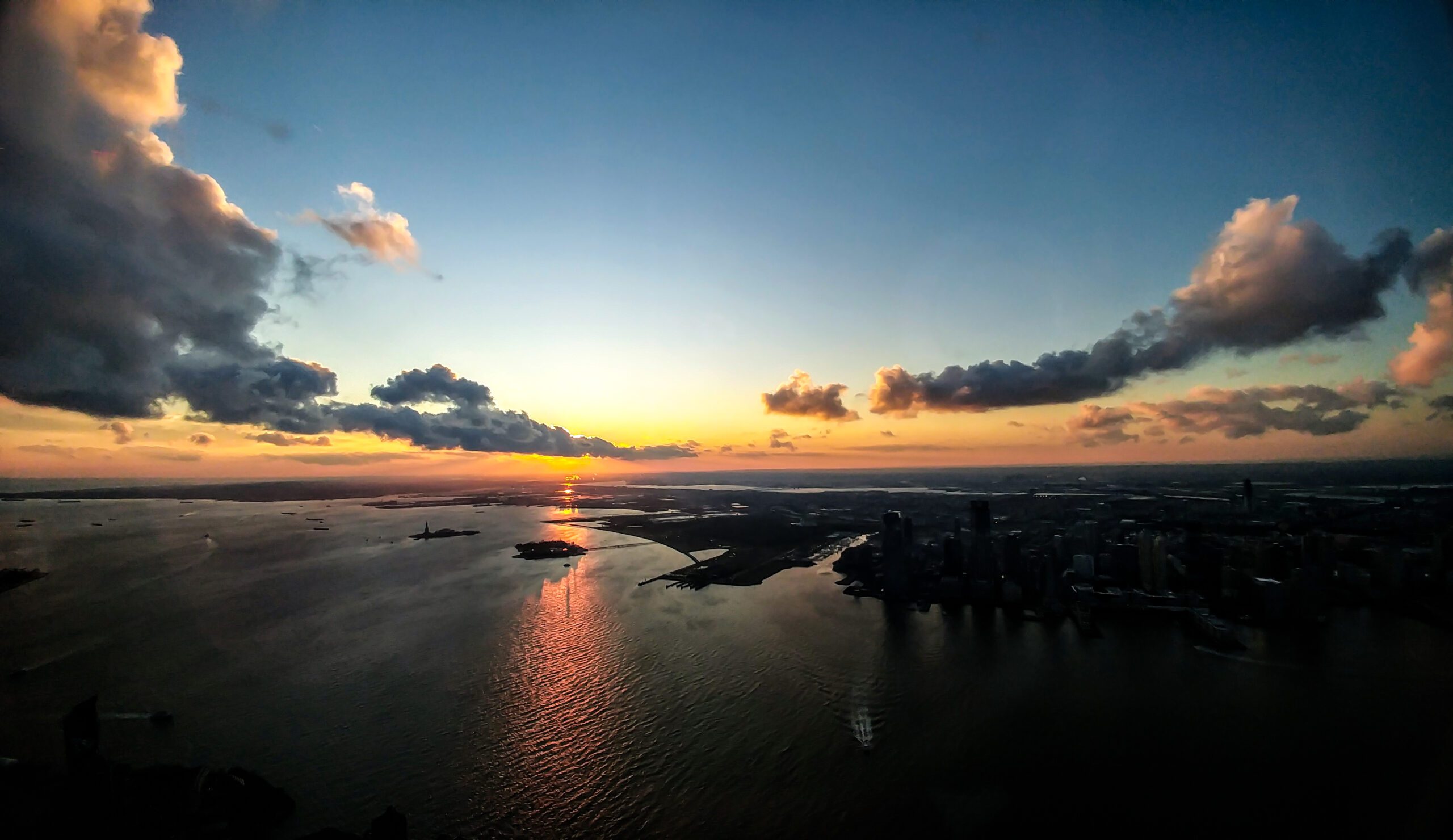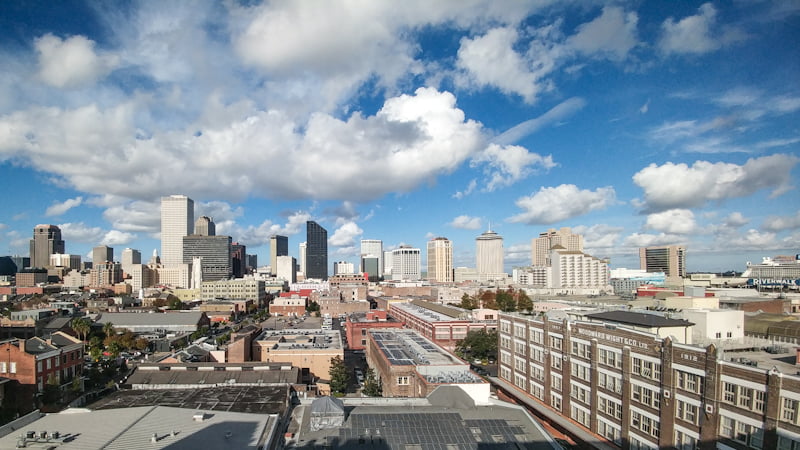

Immersive National World War II Museum in New Orleans
I love a rainy day in New Orleans. It decompresses and washes away all of the thick steamy energy seething in the pavement and naturally you just go with the flow. But there never fails to be somewhere new beckoning us to explore, continually revealing the city’s versatile, often seductive culture, sometimes even without getting hammered.
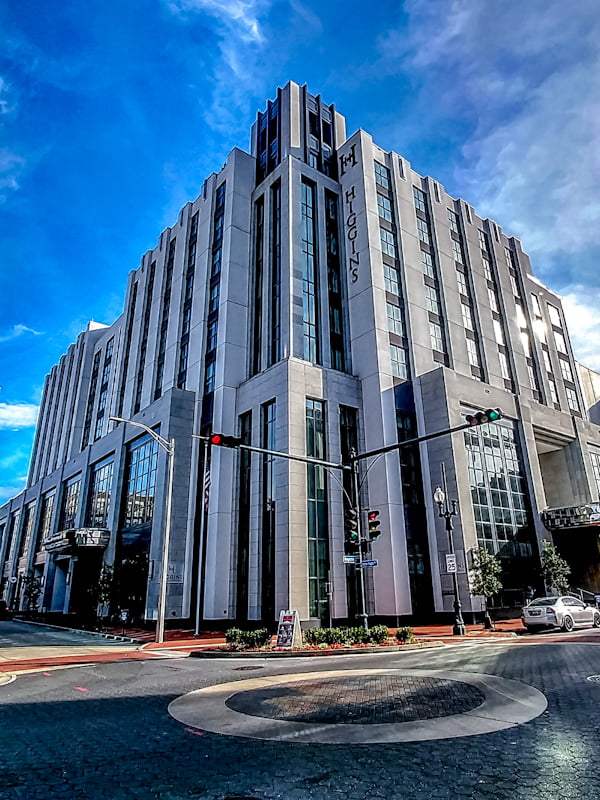

N’awlins is one of my go-to places, so I know it pretty well, but one nostalgic night, I couldn’t resist but do a search for what’s new in NOLA.
Because in the flux of the world’s rebooting after a couple of strange years who knows what’s open or closed or, well, in flux?
In my midnight scrolling, I discovered JamNOLA (what’s that?) and the Museum of the Southern Jewish Experience (is that a thing?) plus the Sazerac House (how can you not?).
But the new exhibits at the high-tech National World War II Museum paired with the new art-deco 1940s era Higgins Hotel on Magazine Street presented some immersive escapism and intrigue.
On board for all of the above, I hopped a flight to the new Louis Armstrong Airport to do some solo travel therapy (love the airport’s new meditation room).
The itinerary seemed to create itself. Visiting New Orleans is like good friends getting together after too long, because there’s always territory to catch up on and it will always be a good time.
The World War II Museum Compound
I had been to the World War II Museum in New Orleans about a decade ago. I was with a friend, and we saw a 1940s Christmas show in the canteen with the museum’s very own delightfully nostalgic 40s-era performers, The Victory Belles.
Since then, the museum has grown into a monumental six-acre compound with five pavilions that house state-of-the-art multimedia exhibits.
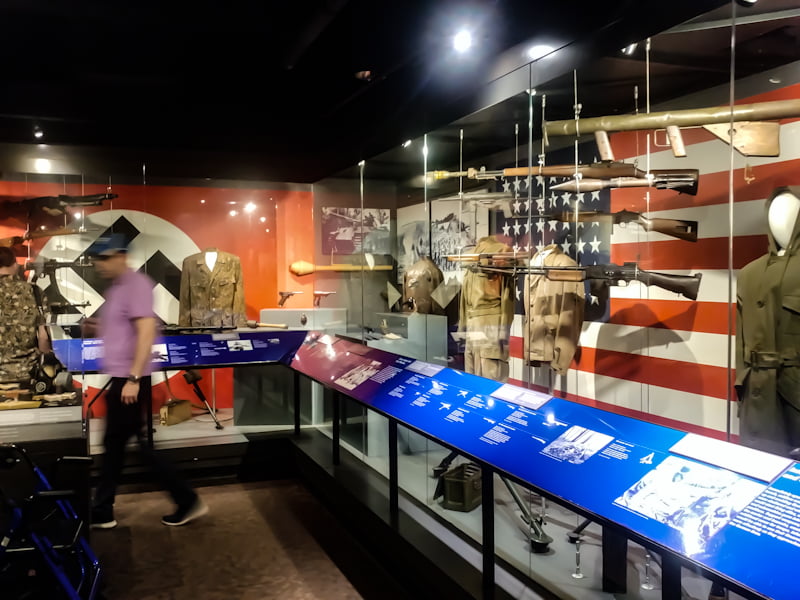

The place transports guests with its collection of hundreds of thousands of artifacts. It’s a theatrical deep dive into the intricacies of why World War II happened and how it changed the world. And of course it explores the nuances of profound tragedies, true heroism, and the infamy.
It is a veritable campus is what it is. And I cannot see any way a person spends a day exploring the immersive stories here and not leave a better, perhaps even more optimistic citizen of the world.
Anyone lacking a grasp on the meaning of idealistic democracy and freedom for all needs this. Stat.
The scope of exhibits from Road to Berlin to D-Day was structured cohesively with vivid details; yet, there was fluidity in the plan to freely explore whatever particularly may draw one’s focus as well.
Palpable Nostalgia
I particularly appreciated the multi-media installations and elaborate displays of war efforts at home; the unity of Americans back then. It’s palpable and heartening.
Somber at times, no doubt, the compound’s accessibility revealed just how deep the effects of the war ran in all corners of the earth. I would have had to be completely numb to not feel the weight. The honor and gratitude for these veterans grew all the more.
Reeled in by actual footage and radio recordings, the immediacy translates very effectively. The exhibits are not the least bit preachy, and they don’t need to be.
For co-founders Stephen Ambrose and Dr. Gordon Mueller with the museum’s board members and supporters, it’s an inspired mission, for sure since its founding in 2000.
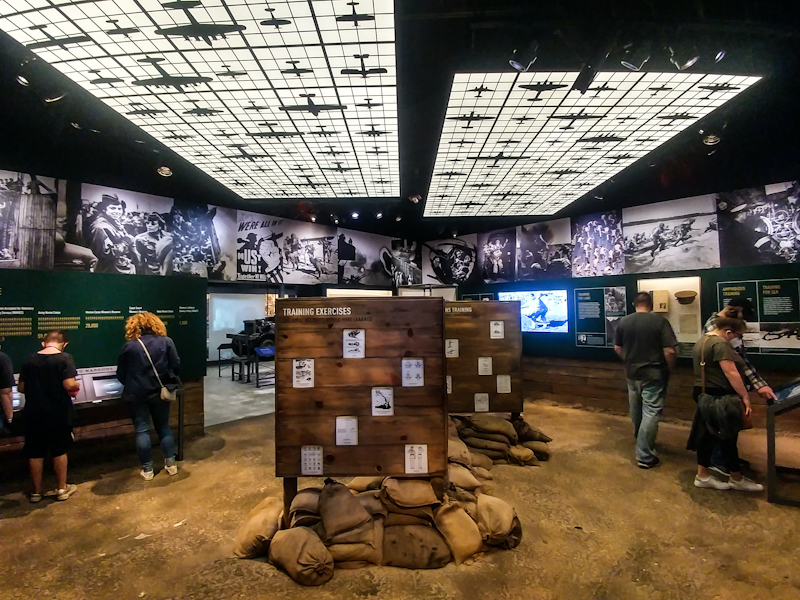

Beyond All Boundaries
Most recently added is the unforgettable 4D cinematic experience of Beyond All Boundaries in the plush one-of-a-kind Solomon Victory Theater. It was created solely for the museum and co-produced by Tom Hanks who also narrates it with a star-studded cast.
I was fortunate to have been there during a national U.S. holiday and was in excellent company with veterans all around.
The powerful special effects go beyond the CGI panorama, enhancing the intense journey and revealing the horrors of war. The experience engages the senses in unexpected ways, so consider that it may not be suitable for children. Reservations are recommended.
The New Orleans Connection
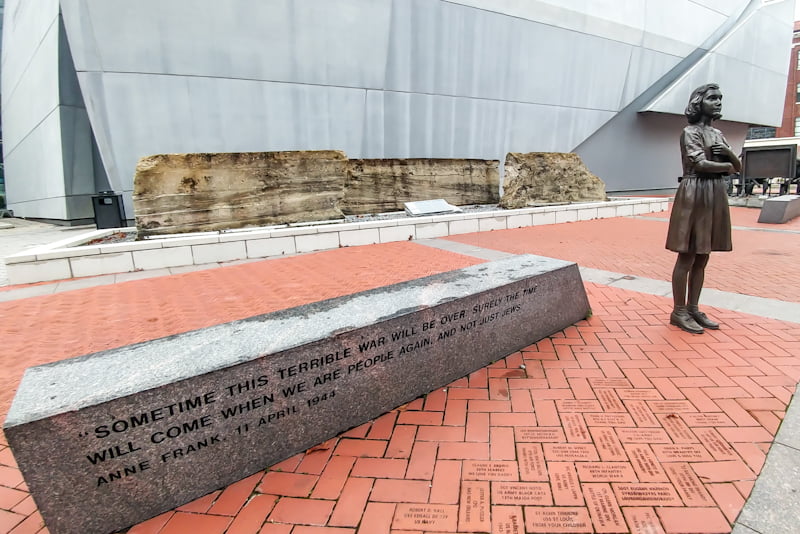

Upon walking into the atrium of the entrance in the museum’s original Louisiana Memorial Pavilion on Magazine Street, the familiar L.W. “Pete” Kent Train Car Experience invites visitors to feel of the passenger experience of the 1940s.
Iconic war relics abound in every direction right away and onward to the newest exhibit, Arsenal of Democracy.
Bronze statues featuring notable figures such as a very solitary Anne Frank stand on the dedicated sidewalks outside. A kitschy 1940s-style soda shop wets the whistles of visitors, as does the more sophisticated restaurant inside.
Canopy of Peace
Soaring in the sky above the entire campus outside is the new Bollinger Canopy of Peace, spanning across the museum’s distinctive architecture, visually unifying the ever-evolving complex.
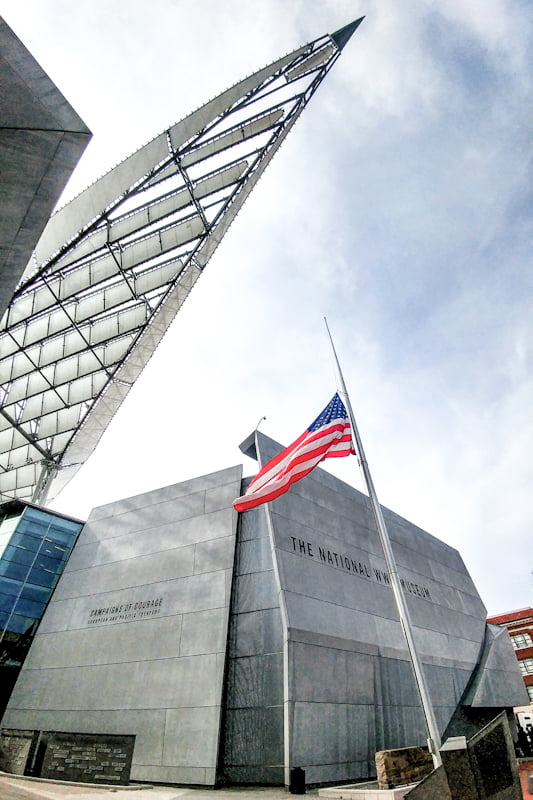


Immediately to the left of the door of the Louisiana Memorial Pavillion by the ticket counter is the famed D-Day boat, the LCVP. It was showcased in the movie, Saving Private Ryan and is known as the Higgins Boat.
More than 20,000 boats were designed and built by New Orleans-based Higgins Industries, owned by Andrew Jackson Higgins. Higgins’ amphibious boats were used in all major operations throughout the war, most notably on D-Day in Normandy.
President Eisenhower himself credited the Higgins boats with playing a crucial role in winning the war.
Eisenhower declared that “If Higgins had not designed and built those LCVPs, we never could have landed over an open beach. The whole strategy of the war would have been different.”
…Hence, New Orleans is the designated location of the National WWII Museum. Explore the Bayou to Battlefield exhibit for a deeper dive into the connection.
Classy Retro at the Higgins Hotel
The Higgins Hotel by Hilton Curio sits adjacent to the WWII Museum complex. In addition to its location at the edge of the Warehouse District, the retro 1940s art deco style bestowed a classy, regal presence. Fittingly, it is indeed the official hotel of the museum.
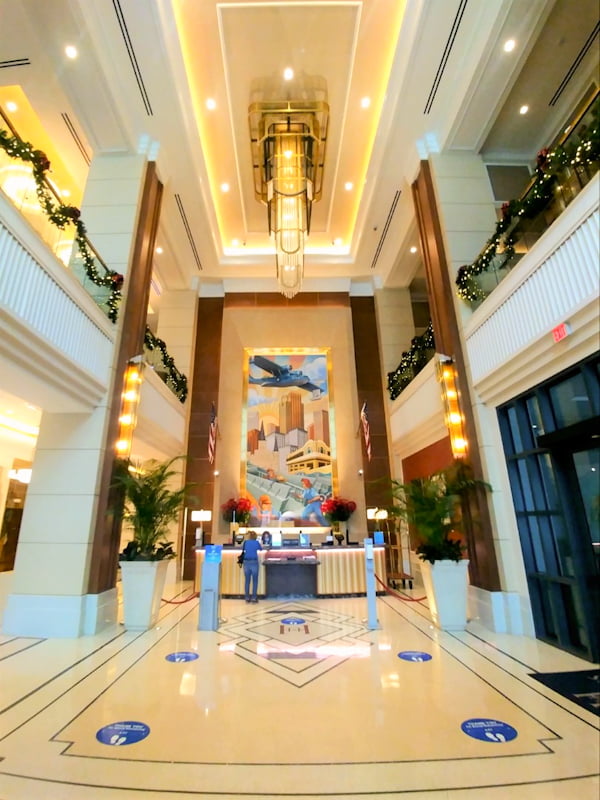

Just walking into the marble lobby bestows a spectacular feeling of strength, elegance, and grandeur consistent with its commanding exterior design. It’s gorgeous.
And while New Orleans tends to honor its heritage ubiquitously in its alluring lodging choices, The Higgins does so outstandingly in its own tributary and cushy way.
Honored to have nabbed the spacious Eisenhower Suite complete with a unique panoramic balcony view, I appreciated its spacious floor plan and all the little details throughout.
The room featured custom art deco furniture including embroidered velvet seating and an elegant dining room with an adjacent kitchenette which was great for my late-night take-out dining from some of the wide array of Mexican in town.
Stunning photography was featured throughout the suite as well as the hotel itself. Each time I walked in the door, I half expected the Andrew Sisters to pop out from behind the curtains and do a number.
The adjustable lighting features offered an array of options working well with the ornate trim and inlays, which I loved. The oversized bedroom and bath were pretty sweet, too. No Bauhaus décor here.
A particularly notable detail for me was the USB-capable turntable and collection of vinyl records spanning a few decades. Martinis with King Cole and Bing? They’ve got that.



Rooftop with Rosie the Riveter
On the main floor, Café Normandie and Provisions offered a lush fine dining experience, plus whatever one might need for some quick morning noshes and espresso.
I wandered for a peek at the sleek conference halls before heading up to Rosie’s on the Roof which overlooks the museum.
Higgins’ marketing director, Marc Becker greeted me there with a warm welcome that paired perfectly with bourbon and beignets with hot chocolate sauce.
If that’s not a proper welcome to New Orleans, I don’t know what is. And to give credit where credit is due, thanks to Executive Chef, Virgile Brandel for the endorphin rush. Calling all beignet aficionados!
But of course, there’s the more traditional classic fare on the local menu created by Brandel to explore here while enjoying the unique terrace view.
Museum of Southern Jewish Experience: Stories Less Told
The experience of Jewish immigrants in the south wasn’t something I’d heard much about. But it’s genuinely part of the fabric of its history. New Orleans truly is the melting pot of the south. The Museum of the Southern Jewish Experience takes visitors on that journey.
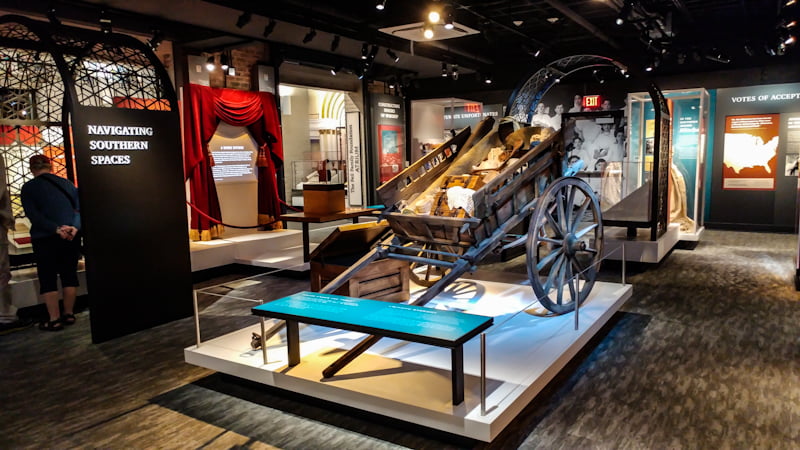

Authors like William Faulkner and Harper Lee incorporated southern Jewish characters in their classic works. And the movie, Driving Miss Daisy, sheds some light as well.
I was curious, so one rainy afternoon I paired one of my visits to the WWII Museum with a visit to the newly opened museum. It was time well spent.
With many strong, distinctive identities in the region, I had questions. How does this 1% of the southern population keep kosher there? Where would one observe Sabbath in the 1800s Bible Belt?
And how did they decide whether to have a bluegrass band or a klezmer band at the wedding? Strangers in a strange land, indeed.
“Spanning three hundred years, the Museum of the Southern Jewish Experience’s core and rotating exhibitions explore the diverse relationships and experiences encountered by Jewish communities in the American South from the Colonial era to today,” Executive Director Kenneth Hoffman explained.
Broad brushstrokes wouldn’t reveal the interesting commonalities, dichotomies, and perhaps ironies in the southern Jewish experience.
For example, the relationship between Jews and African American Slavery. It is a fascinating education on many levels, including learning about Jewish anti-slavery activists, like Leopold Karpeles who helped African slaves escape to Mexico.
The 9,000 sq. ft. space offers exhibits that tell a loosely linear story beginning with frontier land. The linear self-tour finishes with access to an endlessly searchable state-of-the-art database. Art installations and photography provide an intimate look at both the triumphs and challenges of cultural integration and preservation.

